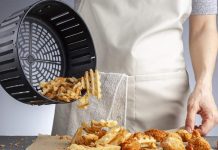Air fryers have become a popular kitchen gadget, promising to deliver crispy and delicious food with little to no oil. But before you jump into the world of air frying, there are a few common mistakes that you’ll want to avoid. From overcrowding the basket to forgetting to preheat, these errors can turn your air frying experience from golden and crispy to disappointing and soggy. So if you’re ready to elevate your air frying game and achieve perfectly cooked dishes, keep reading to discover the 5 mistakes you should steer clear of when using an air fryer.
Cooking without Preheating the Air Fryer
The importance of preheating
One common mistake that many people make when using an air fryer is failing to preheat it before cooking. Preheating the air fryer is essential to ensure that your food cooks evenly and properly. Just like with a conventional oven, preheating allows the air fryer to reach the desired cooking temperature before you add your ingredients. By preheating, you allow the air fryer to distribute heat evenly, resulting in a crispy and golden exterior while preserving the moisture inside.
How to preheat your air fryer
To preheat your air fryer, simply set the temperature to the recommended cooking temperature and let it run for a few minutes until it reaches the desired heat. This typically takes around 3-5 minutes, depending on the model and size of your air fryer. Preheating ensures that your food will cook evenly, minimizing the risk of undercooked or overcooked meals.
Overcrowding the Basket
The negative effects of overcrowding
When using an air fryer, it’s essential to avoid overcrowding the basket with too many ingredients. Overcrowding the basket can prevent the hot air from circulating around the food properly, leading to uneven cooking and potentially soggy or undercooked results. By giving your ingredients the space they need, you allow the hot air to circulate freely, ensuring that each piece is cooked to perfection.
How to avoid overcrowding
To avoid overcrowding the basket, it’s important to cook in batches if necessary. Give each ingredient enough space to ensure even cooking and a crispy texture. This may require additional cooking time, but the end result will be worth it. Remember, it’s better to cook in multiple batches and enjoy perfectly cooked food rather than rushing and ending up with a disappointing meal.
Not Shaking or Flipping the Food
The importance of shaking or flipping
Another mistake to avoid when using an air fryer is failing to shake or flip the food during the cooking process. Shaking or flipping the food helps to ensure even browning and crispiness on all sides. By keeping the food moving, you prevent it from sticking to the basket and promote even distribution of heat. This simple step greatly improves the texture and overall quality of your air-fried meals.
How and when to shake or flip
To shake or flip the food, use tongs or a spatula to gently turn the pieces over or give them a quick toss. You can do this once or multiple times throughout the cooking process, depending on the recipe and the size of the ingredients. For smaller items like french fries or chicken wings, a simple shake or flip halfway through cooking is usually sufficient. However, for larger pieces of meat or vegetables, consider flipping them multiple times to ensure even browning.
Using Too Much Oil
The misconception of oil-free cooking
One of the main selling points of air fryers is the ability to cook with little to no oil. However, this doesn’t mean that you should completely eliminate oil from your cooking process. While it’s true that air fryers require significantly less oil compared to traditional frying methods, a small amount of oil is still necessary to achieve optimal results. Using too much oil can lead to greasy and soggy food, defeating the purpose of using an air fryer.
How to use oil effectively
To use oil effectively in your air fryer, start by lightly coating your ingredients with a small amount of oil. This can be done by tossing them in a bowl with a teaspoon or two of oil before placing them in the air fryer basket. The oil helps to add flavor, promote browning, and prevent sticking. It’s crucial to use a cooking oil with a high smoke point, such as olive oil or avocado oil, to avoid any unpleasant burnt flavors.
Not Cleaning and Maintaining the Air Fryer
The importance of proper maintenance
Maintaining a clean air fryer is crucial for both its performance and longevity. Failure to clean and maintain your air fryer can lead to poor cooking results, unpleasant odors, and potential safety hazards. Regular cleaning removes any residual oil, food particles, and odors, ensuring that your air fryer operates efficiently and produces delicious meals every time.
How to clean your air fryer
Cleaning your air fryer is a simple process that should be done after every use. Start by unplugging the appliance and allowing it to cool down. Remove any removable parts, such as the basket and tray, and wash them with warm soapy water. Wipe down the interior and exterior of the air fryer using a soft cloth or sponge. Pay attention to any hard-to-reach areas or crevices. If stubborn residue remains, use a non-abrasive sponge or brush to gently scrub it away. Finally, dry all the parts thoroughly before reassembling the air fryer.
Not Adjusting Cooking Time and Temperature
The need for customization
Every air fryer is different, and cooking times and temperatures can vary depending on the model. Failing to adjust the cooking time and temperature according to the specific requirements of your air fryer can result in undercooked or burnt food. It’s crucial to understand your air fryer’s capabilities and make the necessary adjustments to ensure perfectly cooked meals.
How to adjust cooking time and temperature
Start by referring to the manufacturer’s instructions for general guidelines on cooking time and temperature. Use these as a starting point and make adjustments based on your experience with your specific air fryer. Keep track of the cooking time and check the food periodically to determine if additional time is needed. Also, take note of the temperature settings that yield the best results for different types of food. With practice, you’ll become familiar with your air fryer’s nuances and be able to customize the settings for optimal cooking outcomes.
Using Incorrect Cookware
The impact of unsuitable cookware
Using incorrect cookware in your air fryer can lead to poor cooking results and potential safety hazards. Air fryers are specifically designed to work with the provided basket or tray, and using other materials or containers can interfere with the appliance’s performance. It’s important to only use cookware that is compatible with your air fryer to ensure efficient and safe cooking.
How to choose suitable cookware
Stick to the cookware that is recommended by the manufacturer for your specific air fryer model. Most air fryers come with a basket or tray that is specifically designed to fit perfectly. This allows for even air circulation and optimal cooking results. Avoid using materials that can melt, warp, or release toxic fumes when exposed to high temperatures, such as plastic containers or aluminum foil. By using the proper cookware, you can ensure that your air fryer functions optimally and that your food cooks evenly and safely.
Adding Wet Batter or Breading
The consequence of wet ingredients
While it’s possible to achieve a crispy exterior with an air fryer, adding wet batter or breading directly into the air fryer can lead to disappointing results. Wet ingredients can create a soggy texture and prevent the food from getting crispy and golden. Instead, it’s important to properly prepare and coat your ingredients before placing them in the air fryer.
How to prepare coated ingredients
When coating ingredients with batter or breading, it’s crucial to follow the proper preparation technique. Start by ensuring that your ingredients are dry before applying any coating. This can be done by patting them dry with a paper towel. Then, dip the ingredients into the batter or breading mixture, ensuring an even coating. For best results, use a batter or breading recipe specifically designed for air fryer cooking. These recipes often include tips on how to achieve a crispy texture without excessive oil. By properly preparing your coated ingredients, you can enjoy the perfect balance of flavor and texture in your air-fried meals.
Not Letting the Food Rest
The importance of resting time
Allowing your air-fried food to rest for a few minutes after cooking is a step that is often overlooked but can greatly impact the overall taste and texture. Resting allows the flavors to develop and the internal juices to redistribute, resulting in a more flavorful and moist end result. It’s a small step that can make a big difference in the quality of your air-fried meals.
How to let food rest
After removing your food from the air fryer, let it rest on a plate or a wire rack for a few minutes. This resting time allows the food to cool slightly and allows the internal heat to distribute evenly. It’s particularly important for meat and poultry, as it helps to retain their juices and tenderness. Use this time to prepare any accompanying sauces or sides, and when the resting period is over, enjoy your deliciously cooked air-fried meal.
Ignoring Safety and Manufacturer Instructions
The significance of following instructions
Ignoring safety and manufacturer instructions when using an air fryer can put you at risk and potentially damage the appliance. These instructions are designed to ensure proper usage and prevent accidents or malfunction. It’s important to familiarize yourself with the safety guidelines and instructions provided by the manufacturer to ensure a safe and enjoyable cooking experience.
How to prioritize safety
Start by thoroughly reading the instruction manual that comes with your air fryer. Pay attention to any specific safety precautions and guidelines provided by the manufacturer. Some common safety measures include ensuring proper ventilation, avoiding overfilling the basket, and keeping the appliance away from flammable materials. Additionally, always use oven mitts or heat-resistant gloves when handling the hot basket or tray. By prioritizing safety and following the manufacturer’s instructions, you can confidently and responsibly use your air fryer.
In conclusion, cooking with an air fryer can be a fun and convenient way to enjoy delicious and healthier meals. By avoiding common mistakes such as neglecting to preheat, overcrowding the basket, not shaking or flipping the food, using too much oil, neglecting maintenance, not adjusting cooking time and temperature, using incorrect cookware, adding wet batter or breading, not allowing the food to rest, and ignoring safety and manufacturer instructions, you can maximize the potential of your air fryer and create mouthwatering dishes that will impress both yourself and your loved ones. Happy air frying!



































